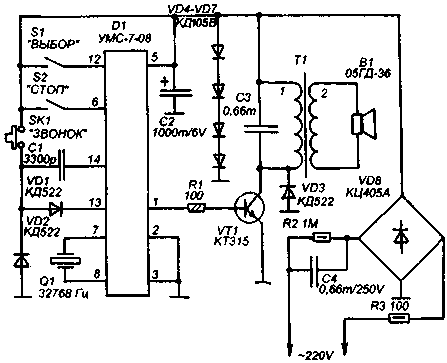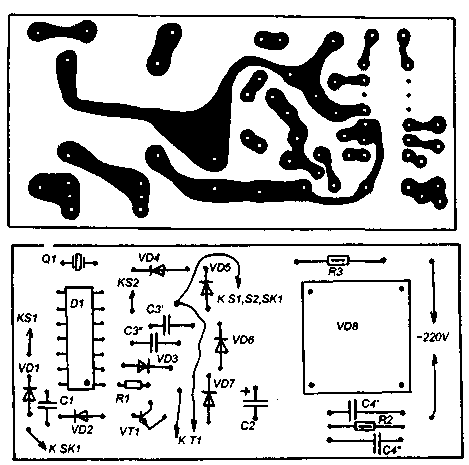Now nobody is surprised if when pressing the bell button at the front door of the apartment, instead of the usual "Tr...R" or "Ding-Dong" bell fragment of popular pieces of music or voice of animals and birds. In stores that sell home electronics, there are many choices of domestic and foreign musical calls, which are often even cheaper than conventional Electromechanical. Most domestic calls are based on a chipset series UMC-7 or UFT-8, enabled by almost the standard scheme. In Amateur literature has repeatedly described the shortcomings of the model scheme (the sharp sound caused by the pulsed nature of the output signal, briefly press the button "start" the first tune sounds to the end, etc.) and proposed a modified scheme of (L. 1, L. 2).
Figure 1 in the text shows a diagram of another version of such a call.

Fig.1
Unlike typical that the sound became more relaxed and soft, and press the button "CALL" the device completely loses a piece of music. The sharpness of tone that is included in the model scheme due to the fact that the dynamic driver that is included in the collector circuit of the output transistor switch, proceed unipolar rectangular current pulses. While such a signal rich in high frequency harmonics that are coming into resonance with the coil of the speaker and its mechanical systems and acoustic design, give a music fragment, not his usual color. In addition, the current flowing through the voice coil speaker has a constant component, which shifts the diffuser and reduces the volume. In the intervals between the different sections of a song appear in a loud and sharp clicks caused by this differential DC component.
In addition, the transistor operation key in a pulsed mode at low load leads to the fact that the resistance of the transistor in saturation mode is much larger than the voice coil of the dynamic head. Therefore, a significant portion of energy is spent on heating of the transistor and not to the build-up of the diffuser.
These drawbacks can be eliminated if the speaker connected to the output transistor of the cascade via a matching transformer having a high impedance primary winding and a low impedance secondary. Additionally, including parallel to the primary winding of the capacitor, we obtain an oscillatory circuit tuned to the mean frequency of musical fragments. The presence of a coordinate transformer low-impedance coil speaker with a relatively high resistance output key, and the presence of the resonant circuit smoothes rectangular pulses, making them more similar to the sinusoidal and suppresses unwanted high frequency harmonics. Since the factor of the circuit is not high, played all the notes laid out in a jukebox.
The presence of resonance in the circuit causes the voltage on the primary winding of the transformer is slightly above the supply voltage of the chip, and it leads to increase the sound volume.
The second defect model scheme is that when a momentary short press the "CALL" melody sounds. The fact is that the playing time in this case is determined not by the length of a musical fragment, and the capacitance of the locking release button. In the circuit shown in figure 1, with the inverted output of the chip (pin 14) impulses through C1 receives the detector VD1 and VD2, so on the 13th output of the chip will contain all unit time that a piece of music.
Eats music a call from a transformerless power source to the rectifier D8 and parametric stabilizer composed of a chain of diodes VD4-VD7, which together falls to 2-2. 5 In and the quenching of the reactive resistance of the capacitor C4. The capacitor C2 smoothes pulsations derived DC.
As the basis for a call is used translational subscriber loudspeaker "Etude". It has a plastic case, speaker and transformer. All this is used in design, except for the volume control, which is excluded.
Most of the details of the call are on a small-sized circuit Board, drawing and wiring diagram of which is given in the text.

Fig.2
Board made of Micarta with double-sided folgirongi. You can use another foil insulation material used for printed circuit boards. On the Board are the buttons S1 and S2 (SK1 displayed on the front door) and the transformer.
The chip can be UFT-8 or UMC-7, additional digits (for example UMC-8-08) say about the musical repertoire of the chip. The buttons S1 and S2 are placed on the body of the call, with the S1 button to select the melody for later playback, and press S2 to stop the playback.
The capacitors C3 and C4 each composed of two parallel connected capacitors 0.33 UF each, to the circuit they are marked as NW' NW 'and C4' and C4".
Rectifier bridge CCA can be replaced by a bridge made up of diodes CDW or CDW,D226.
In the absence of the substrate, you can use the transformer from the output stage of an old transistor radio and any speaker of 0.1-3 watts.
The establishment of a correctly assembled device from the healthy parts consists in choosing the value of capacitor C1 in such a way that when pressing the SK1 was full, single playback of a song. If the capacitance C1 is too high, the machine can play the melody several times in a row. Optionally, you can choose more accurately the capacitance C3, so that the timbre and volume of the sound were the best.
Literature
1. On chips series UMS. Radio 12-1995, pp. 40-41.
2. Melodic apartment calls. Crystal set kit an 11-99, pp. 24-25.
Author: That Is Why V.; Publication: N. Bolshakov, rf.atnn.ru






